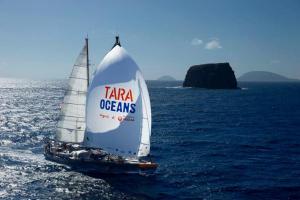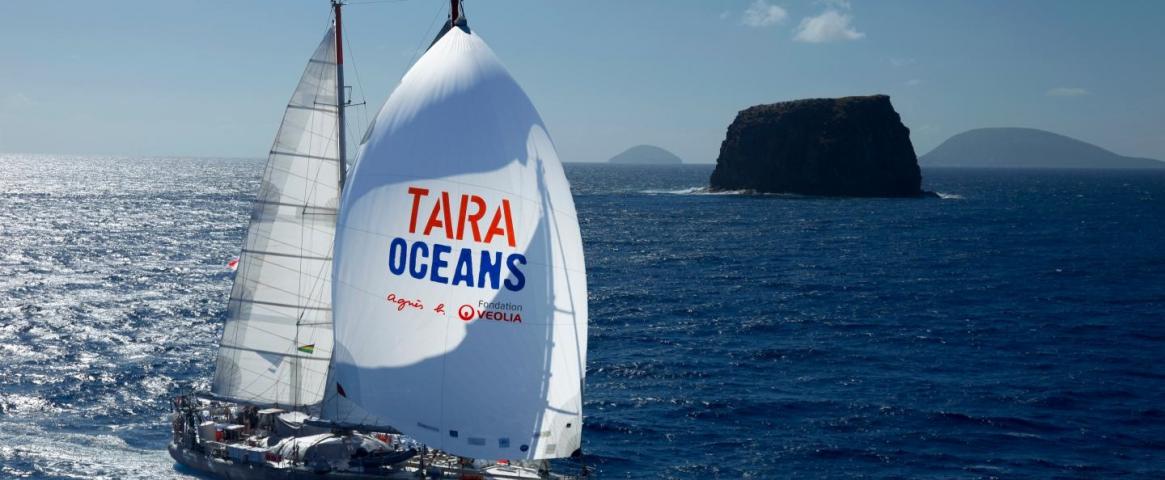By Adam Peasley

“Viruses are nanoscale entities with global-scale impacts,” said Matthew Sullivan, a microbiologist at The Ohio State University, during a Feb. 17 session at the annual meeting of the American Association for the Advancement of Science.
The session outlined the work of three biologists who are exploring viral influence on climate change and expanding biologists’ understanding of competition between viruses and viral strategies.
Sullivan participated in the Tara Expeditions, an ongoing international effort to further ocean science. Using data gathered during those expeditions, his team discovered that viruses may play a crucial role in mitigating climate change.
As levels of carbon dioxide climb globally, the gas dissolves into the sea, raising the water’s acidity and temperature. Although viruses can’t reduce the ocean’s carbon dioxide level by themselves, they may increase the rate at which their microbial hosts capture carbon. Tara’s data show that viruses, more than any other organisms, drive carbon dioxide out of ocean currents.
Sullivan offered two possible explanations. First, when viruses cause their host cells to break apart, the carbon-containing leftovers from the explosion may clump together to form dense aggregates that sink to the ocean floor. Alternatively, aquatic grazers may be attracted to virus-infected cells and produce fecal matter that sinks to the ocean floor.
Besides expanding knowledge of viruses’ effects on the environment, the expedition also radically increased the number of known viral genomes.
“When we started our work, there were essentially 2,000 virus genomes that had been sequenced. We now know about 30,000 virus genomes,” Sullivan said.
Alison Buchan, a microbiologist at the University of Tennessee, Knoxville, uses genomics to investigate competitive and cooperative relationships between viruses.
Buchan’s research involves just one variety of marine bacteria: Roseobacter, an abundant strain found virtually anywhere in the ocean, from coasts and the open ocean to sea ice.
Buchan’s team investigated the effect of viral competition in Roseobacter’s two modes of existence: as nomadic plankton floating freely through the ocean, and as biofilms, colonies of bacteria adhering to an oceanic surface.
The team began by making two cultures of Roseobacter: one containing only cells with genetic information from a virus prone to breaking its host cell, and the other containing only cells with genetic information from a less destructive virus.
The study found that when Roseobacter plankton were left in a liquid medium for 24 hours, the growth of the cells containing a virus more prone to breaking its host cell lagged behind the less destructive virus by half. When the two kinds of virus-contaning cells were added to a single culture in equal parts and allowed to compete for a day, the resulting total cell density was only 1 percent the density of either sample containing only one virus type.
However, the biofilm variety of Roseobacter told a different story. The sample containing only the more destrutive virus yielded a mature biofilm. The sample harboring the virus less prone to breaking cells bore less vigorous growth levels. But what’s more, the growth of the biofilm containing both types exceeded even the first, mature biofilm.
In other words, competition hindered viral success in the Roseobacter plankton, but cooperation promoted viral success in the Roseobacter biofilm.
Having found that viruses can either benefit or suffer from presence of another virus in cultures of Roseobacter, Buchan’s lab now hopes to see what’s possible in more complicated scenarios.
“This is a very simplistic system,” Buchan said. “Moving forward, we’re interested in looking to see what happens when you introduce both virus-bacterial pairs into a complex community, both planktonic and biofilm-associated.”
Meanwhile, Joshua Weitz at the Georgia Institute of Technology is investigating strategies viruses use to succeed.
Viruses that infect bacteria don’t always burst the cells of their hosts. In certain circumstances, they incorporate their own DNA into that of a host cell’s, then stop there. They don’t hijack the cell’s protein-making structures, they don’t tear open the cell’s membrane, and they only pass on their DNA as the cell naturally divides.
This less aggressive strategy interests biologists. Why would viruses choose to leave their hosts alive?
“Why aren’t they immediately releasing new viruses back into the environment?” Weitz asked.
Weitz, a quantitative biologist, leads a lab that creates mathematical models for viral fitness. Because an inhospitable extracellular environment or a lack of susceptible cells nearby can affect virus survival, these models take resources, hosts, viruses and nutrients into account.
“These strategies are combined with ecological context to understand how different strategies may do better at different points,” Weitz said. “There’s not a single viral strategy that’s going to outperform the others.”
Adam Peasley is a chemistry student at Austin Community College and works as a copy editor. He also serves as president of his school’s chemistry society and runs a private tutoring business. Reach him at adam.peasley@gmail.com.

